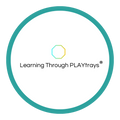Tuff Tray Ideas for Preschools - 52 Weeks of PLAYtrays - Sensory Play and Learning

Table of contents
Welcome to a year of endless creativity and learning with our 52 Weeks of PLAYtrays! Designed to ignite your preschoolers' curiosity and enhance their sensory skills, these Tuff Tray setups offer lots of benefits for early childhood development. From Tuff Tray Sensory Play Ideas to Preschool Sensory Activities , each week brings a new adventure that's both educational and incredibly fun.
Best of all, it's 100% FREE with a Tuff Tray from Learning Through PLAYtrays!

What Are TUFF TRAY Provocation Posters?
Ever wondered how to spark little minds into big actions? Enter provocation posters! These aren't just any posters; they're an invitation into a world of imaginative play. Each one poses a simple question: "Can You...?" designed to prompt your children to think, explore, and create. These posters are ideal for Interactive Sensory Play for Kids.

Benefits of Educational Play with Tuff Trays
Why incorporate Educational Play with Tuff Trays into your teaching? Because they make learning visible and tactile. These sensory trays help children grasp complex concepts like counting, sorting, and thematic thinking in a natural, engaging way. Plus, they’re just plain fun!
Incorporating Tuff Trays into your daily routine is easier than you might think. Start with simple setups that require minimal preparation but offer maximum learning potential. Whether it’s a sensory bin or a thematic learning station, these trays allow you to cover various educational goals in a single setting.

Frog Pond
Place flashcards featuring frogs around your Tuff Tray. Pre-soak chia seeds so they have a gelatinous, pond-like texture.Use green food coloring to give the chia seeds a vibrant, pond-green look. The chia seed ponds looks like tadpoles - perfect for the frog life cycle theme. This not only looks cool but feels amazing under little fingers! This sensory-rich activity helps children develop fine motor skills as they handle the slippery chia seeds.

We're Going on a Leaf Hunt
This autumn-themed activity uses flashcards of colorful leaves. Color rock salts with yellow and orange food coloring to represent autumn leaves. Use sliced paper towel rolls shaped into ovals to form a tree on your Tuff Tray, then let the kids fill in the tree with colored salts. This activity offers a hands-on learning experience about seasonal changes.

Bees and Honey!
Spring into learning with our "Bees and Honey!" activity that combines sensory exploration with educational flashcards about nature's busy pollinators. Create a tactile experience by making a 'honey hive' using yellow gelatin. Mix plain gelatin with yellow food coloring to simulate honey. Pour this mixture into molds or simply let it set in a shallow container. Once the gelatin is set, invite the children to explore the 'honey hive'. This sensory experience is excellent for building strong finger muscles as kids squish and poke the gelatin. The slightly sticky texture mimics real honey!

Penguin Ice Skating Rink
Winter weeks can be magical with our "Penguin Ice Skating Rink" setup. Here’s how to bring this chilly fun to your classroom or home. Start by using chalk to draw wobbly skating lines across your Tuff Tray. Introduce the cute penguin flashcards. Encourage children to use them in pretend play, creating scenarios where penguins might be racing each other or performing tricks on the ice. This activity is not only fun but also great for developing fine motor skills

When you use flashcards with sensory play together, you give PLAY a meaningful purpose
Sensory Play for Toddlers: Why It Matters
Sensory play is all about letting toddlers and kids explore and learn through activities that use their senses. Things like playing with playdough, splashing water, or finger painting are not just fun; they teach important skills too. You can make sensory play even more educational by using flashcards. For instance, if your toddler is playing with water, you can use fish flashcards to talk about different sea creatures. This way, they learn while they play.
Learning About the World: Sensory play helps toddlers figure out how things work. It’s like hands-on learning that makes them better at solving problems as they grow.
Talking More: As kids play, they talk about what they do, like how squishy the playdough feels. This helps them learn new words and get better at communicating.
Getting Handy: Playing with small things like sand or beads helps little fingers get better at moving, which is important for tasks like drawing or tying shoes later on.
Staying Calm: Sensory activities can help calm toddlers down. Playing with soft sand or molding playdough can turn a TUFF moment into a peaceful one.





